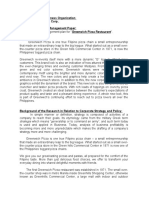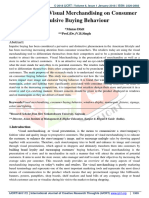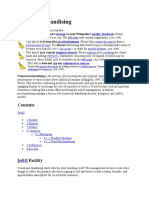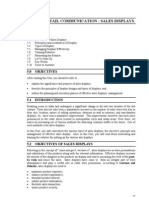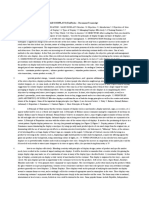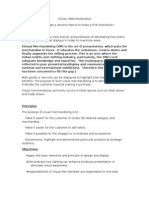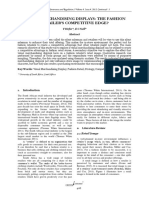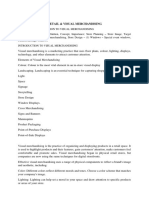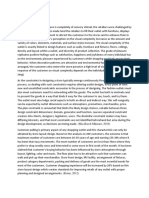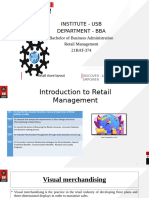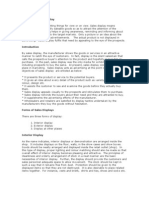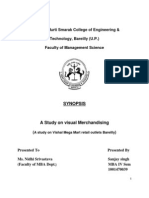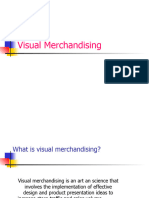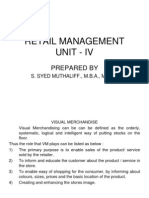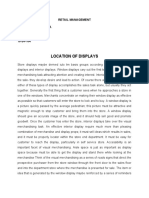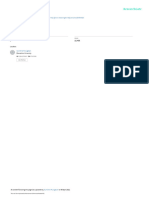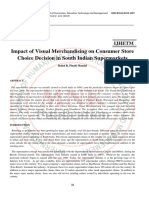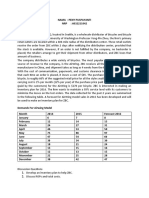0 ratings0% found this document useful (0 votes)
244 views95087601
95087601
Uploaded by
Ale MoradaThis paper investigates the attitude of consumers towards visual merchandising in Apparel Purchase Decision. A store has to display the product in a way that it attracts the customer and persuade them to buy the product. Consumers expect to shop in a store with good ambience.
Copyright:
© All Rights Reserved
Available Formats
Download as PDF, TXT or read online from Scribd
95087601
95087601
Uploaded by
Ale Morada0 ratings0% found this document useful (0 votes)
244 views19 pagesThis paper investigates the attitude of consumers towards visual merchandising in Apparel Purchase Decision. A store has to display the product in a way that it attracts the customer and persuade them to buy the product. Consumers expect to shop in a store with good ambience.
Copyright
© © All Rights Reserved
Available Formats
PDF, TXT or read online from Scribd
Share this document
Did you find this document useful?
Is this content inappropriate?
This paper investigates the attitude of consumers towards visual merchandising in Apparel Purchase Decision. A store has to display the product in a way that it attracts the customer and persuade them to buy the product. Consumers expect to shop in a store with good ambience.
Copyright:
© All Rights Reserved
Available Formats
Download as PDF, TXT or read online from Scribd
Download as pdf or txt
0 ratings0% found this document useful (0 votes)
244 views19 pages95087601
95087601
Uploaded by
Ale MoradaThis paper investigates the attitude of consumers towards visual merchandising in Apparel Purchase Decision. A store has to display the product in a way that it attracts the customer and persuade them to buy the product. Consumers expect to shop in a store with good ambience.
Copyright:
© All Rights Reserved
Available Formats
Download as PDF, TXT or read online from Scribd
Download as pdf or txt
You are on page 1of 19
37 The Role of Visual Merchandising in Apparel Purchase Decision 2014 IUP. All Rights Reserved.
The Role of Visual Merchandising
in Apparel Purchase Decision
* Associate Professor, Department of Fashion Management Studies, National Institute
of Fashion Technology, Dharmasala, Mangaattuparamba, Kannur 670 562, Kerala,
India. E-mail: m_krishna34@hotmail.com
M Krishnakumar
Introduction
As the retail business moves from the product to the spacethe storewhere all
the things happen, the shopping ambience has become important now, with the
retailer giving their stores a contemporary and consumer-friendly design, and
consumers expecting to shop in a store with good ambience. Shopping has become
a brand experience rather than merely a transaction (Singh, 2009). The moment of
real purchase takes place at the point of purchase where the decision on how
much to buy is made. The stores future depends on what the consumer sees and
experiences at the store (Lamba, 2003). Retail design and visual merchandising
play a crucial role in creating this difference. Visual merchandising, also regarded
as a silent salesman, is the science and art of suggestive selling by display and
presentation. Visual merchandising focal points are placed strategically in the store
and communicate the features and benefits of the merchandise. An effective window
As retail business is moving towards new phases, the emphasis is slowly changing
from the product to the spacethe storewhere all the things happen. The
shopping ambience becomes so important now, with retailers being interested
in giving their stores a contemporary and consumer-friendly design. Consumer
behavior, which was earlier termed as overt behavior, is a continuous
consumption process related to pre-purchase, purchase and post-purchase
issues. A store has to display the product in a way that it attracts the customer.
Visual merchandising is an art of displaying the things in an attractive way so
that it could attract the attention of the customer and persuade them to buy the
product. An effective visual merchandising will play a significant role in the
consumers purchase decision. This paper investigates the attitude of consumers
towards visual merchandising in apparel purchase decision.
The IUP Journal of Management Research, Vol. XIII, No. 1, 2014 38
display will attract the passerby and convert them into browsers and spenders
through the process of conversion. Retail companies are increasingly spending on
both the environment and the fixtures and stylish fittings, emphatic lighting and
digital signage, and are in for an international appeal and inviting feel (Nupur,
2009; and Arti, 2010).
Review of Literature
Consumer Behavior
Consumer behavior which was earlier termed as overt behavior is a continuous
consumption process related to pre-purchase, purchase and post-purchase issues.
This refers to the physical action of consumers that can be directly observed and
measured by others. According to Solomon and Rabolt (2004), consumer behavior is
the study of the processes involved when individuals or groups select, purchase, use
or dispose products, services, ideas or experiences, to satisfy their needs and desires.
According to Kardes (2002), consumer behavior is the study of human or consumer
responses to products and services; and the marketing of products and services.
The concept of modern consumer behavior is that people mostly buy products
not for what they do but for what they stand for. This concept implies that the
product plays a role beyond their functional purposes for which they are actually
meant. For example, among the products having similar or equal qualities or
features, a consumer may select the product which has an image. Consumers
tend to establish a relationship with the product they like (Paromita, 2007; Paul
and Olson, 2007; and Saumya et al., 2010).
Visual Merchandising
Every customer wants to see the product before they purchase. The store has to
display its products in a manner that attracts the customer. Visual merchandising
is an art of displaying the things in an attractive way so that it could attract the
attention of the customer and persuade them to buy the product. It is the use of
visual effects to stimulate the customers to buy. It is the means to communicate a
stores fashion message to a prospective customer. Visual statements made in the
store windows or displays are the customers first view with the store. And since
many similar fashions are available, creating a unique impression on the customer
is the basis for the survival of a retail store. So the display must effectively convey
the stores image and fashion focus. It is also termed as the silent salesperson
(Gopal, 2006; Martin, 2007; and Pooja, 2010).
Visual merchandising is a team effort involving management, merchandising
manager, visual merchandiser, sales associates and so on. Visual merchandising
is done based on merchandising themes. Merchandising themes are planned
many months in advance in conjunction with the seasons, store promotion and
arrival of new merchandise. Visual merchandising is related to retail merchandising.
39 The Role of Visual Merchandising in Apparel Purchase Decision
The difference is that visual merchandising is the process of using appealing
visual effects to stimulate sales (Sharmila and Anjali, 2008), whereas retail
merchandising is the process of actually making those sales. The factors to be
considered while designing a store are:
Designing the sections keeping the various categories in mind;
Designing a merchandise plan for the store. The architect should be able
to maintain and reveal the merchandise plan as it is the initial point for
any retail store design;
The layout should be designed in such a manner that the flow of traffic
within the store is regulated; and
Front elevation is a crucial factor while designing/planning the store
(Ernest, 1987; Ellen, 2007; and Michael et al., 2008).
Visual merchandising uses fundamental design principles while working with
various materials and colors. A successful visual display is made in a variety of
forms like: themes, colors, mannequins, forms, fixtures, hangings, poles or stands,
platforms, paintings and wall-decoration, fabrics, table cloths and banners, tables
and furniture, lighting effect, accessories and props and music (Gini, 2005; Kisholo,
2008; and Vedamani, 2010).
Visual Merchandising Techniques
Visual merchandising techniques are mainly of two types: 1. Interior Display; and
2. Exterior or Window Display.
Interior Display
As a customer walks inside the store, the interior display should guide and persuade
the customer to purchase (Icfai University, 2003; and Retail Customer Experience
Magazine, 2008). The interior display of the store includes the following:
Store Layout: The plan that allocates a specific location or space to each
of the merchandise departments as well as each of the non-selling areas;
e.g., Mens wear, womens wear, etc.
Store Design: The decorative style or dcor used by the store to convey
the image it wants to project to the customer. This includes a selection of
wall-coverings, carpets, furnishings, shelves, dividers, pictures and
planters.
Display Space: Free spaces which are used for display, e.g., columns,
ledges (built in shelves), platforms, islands, fascia (shelves used to hide
recessed lighting), walls, shadow boxes and hangings.
Vignettes: A product or group of products shown in use in a special small
space is a vignette.
Item Display: A single garment or accessory may be featured in an item
display; different colors and sizes of one product.
The IUP Journal of Management Research, Vol. XIII, No. 1, 2014 40
Assortment Display: A display that shows, identities and prices of each of
the style currently in a section of stock.
Other Types: The other types of interior display include:
Counter card: A hanging card which describes the good qualities
Signage: This refers to all the printed wordings that carry the stores
message to the customers and embodied in all manner of shapes and
forms, simple and elaborate (Newman and Peter, 2008).
Exterior Display
An exterior display attracts the prospective customers who pass by or who are at
a distance. The exterior display includes: window display and store front.
Window Display: A store window is useful for selling merchandise,
promoting an idea or publicizing the store. The primary function of a
window display is to make the passerby purchase. They are designed in
such a way that they convey one of the several different kinds of messages
to the customer, to show seasonal trends in fashion colors or looks, to
show how to wear a specific merchandise to achieve a particular look, or
to show what the store has available at various price lines (Business
Standard, 2006; and Sandhya, 2008). There are different types of window
displays used: (a) Closed-back window; (b) Corner window; (c) Elevated
window; (d) Island window; (e) Lobby window; (f) Masked window;
(g) Mock window; (h) Open-backed window; (i) Ramped or racked window;
and (j) Shadow-box window.
Store Front: The store front is the area that is surrounding the entrance
way. There are four different types of store fronts: (1) Straight front;
(2) Angled front; (3) Arcade front; and (4) Corner front.
Visual Merchandising in India
When compared to the western countries, visual merchandising in India is still at
its nascent stage. In western countries, it is very much organized and given
significant consideration in the corporate planning activities. But in India, it is in
the initial stage and is coming up very actively. Indian retailers have realized the
importance of visual merchandising in attracting the customers, increasing the
footfalls, providing unique shopping experience, and creating the actual purchase
(Images Retail, 2008; and Retail Biz, 2009). Retail companies are increasingly
spending on both the environment and the fixtures and stylish fittings; emphatic
lighting and digital signage for an international appeal and inviting feel. According
to the industry estimates, an average of 25-40 lakhs is being spent per store.
For example, Arrow spent about 2 crore on what it claims to be its largest store
in the world at Bangalore (4000 sq.ft). Wrangler had done up its most recent
41 The Role of Visual Merchandising in Apparel Purchase Decision
store based on the cowboy theme to reflect its brand image. It spent about 1.5
crore on its 3000 sq.ft store in Bangalore. While most brands and retailers outsource
work to design houses both local and international, Future group has its own in-
house design company, Idiom, which employs close to 200 people who are
constantly working on design ideas. Globally, the store design concepts are changed
once in two to three years. In India, most of them do it in once in five years.
The store concept is changed once the market reaches saturation level (Srinivasan,
2006; The Economic Times, 2006; and Kishore, 2007).
Objectives of the Study
The study aims to achieve the following objectives:
To understand the attitude of consumers towards visual merchandising
in apparel purchase decision;
To create awareness among the retailers about visual merchandising;
and
To determine the visual merchandising factors that influence apparel
purchase decision.
Research Methodology
This study is exploratory in nature. The area selected for the study is Coimbatore,
Tamil Nadu, and is done during 2011. Coimbatore is a cosmopolitan city inhabited
by people belonging to different categories. The cost of living is medium and the
peopl e gi ve much i mportance to shoppi ng experi ence. Non-probabi l i ty-
convenience sampling method was selected for the study. The respondents are
individuals of household. A sample size of 100 respondents was selected for the
study. Data was collected through a questionnaire survey (refer Appendix). The
questionnaire was given to the respondents with a request to return after
completing the same. The respondents were asked to rate their answers on a 5-
point Likert type scale ranging from 1 Highly Agree to 5 Highly Disagree.
Before applying this method, a pilot study for testing the questionnaire was
conducted. This reveals the weaknesses of the questionnaire, if any. Open-ended
questions were designed to get free responses from the respondents who give
actual facts. The data was analyzed and interpreted using simple percentage
analysis, ranking, Analysis of Variance (ANOVA) and t-test.
Results and Analysis
Descriptive Statistics
The demographic details showing the age, gender, occupation and qualification of
the sample are presented in Table 1.
The IUP Journal of Management Research, Vol. XIII, No. 1, 2014 42
Agreeability of Visual Merchandising Statements
It is observed from Table 2 that the overall weighted average is 1.807, which means that
a majority of the customers have responded between Highly Agree and Agree. This
shows that visual merchandising plays a significant role in the apparel purchase decision.
Table 2: Agreeability of Visual Merchandising Statements
1. Visual merchandising is helpful in 48 44 8 0 0
making apparel purchase decision
2. I prefer to shop in the store, where visual 38 56 6 0 0
merchandising is done attractively
3. Store front plays important role in 43 50 4 3 0
attracting the customer
Highly
Agree
Dis-
agree
Neutral Agree
Statements S. No.
Highly
Dis-
agree
Table 1: Descriptive Statistics
Age (Years) No. of Respondents Percentage
< 18 6 6
18-25 27 27
25-32 29 29
> 32 38 38
Total 100 100
Gender
Male 58 58
Female 42 42
Total 100 100
Occupation
Business 18 18
Professional 31 31
Employee 23 23
Other 28 28
Total 100 100
Qualification
School 8 8
Diploma 8 8
Undergraduate (UG) 45 45
Postgraduate (PG) 39 39
Total 100 100
43 The Role of Visual Merchandising in Apparel Purchase Decision
Table 2 (Cont.)
4. Store design is also important in
purchasing criteria 33 54 10 3 0
5. Visual merchandising done in accordance
with the merchandise theme
increases the chance of buying decision 23 60 17 0 0
6. Good lighting will enhance apparel
buying decision 55 38 7 0 0
7. Good mild music will create mood and
induce the purchase decision 41 44 15 0 0
8. Like to see catalogues to make purchase
decision 33 46 17 4 0
9. Tend to buy on impulse 21 41 27 11 0
10. Visual merchandising with related
accessories will increase chances 33 50 12 5 0
of purchase decision
Total 368 483 123 26 0
Average 36.8 48.3 12.3 2.6 0
Percentage (%) 36.8 48.3 12.3 2.6 0
Weighted Sum 368* 483* 123* 26* 0
1=368 2=966 3=369 4=104
Weighted Average 1807/1000 = 1.807
Highly
Agree
Dis-
agree
Neutral Agree
Statements S. No.
Highly
Dis-
agree
Ranking Analysis
Ranking of Visual Merchandising Factors
It is observed from Tables 3 and 4 that the total weighted average shows that
Quality gets Rank 1, Color gets Rank 2, Style/Design gets Rank 3, Size gets
Rank 4, Price gets Rank 5 and How to Dress gets Rank 6.
Table 3: Ranking of Visual Merchandising Factors
Factors Rank 1 Rank 2 Rank 3 Rank 4 Rank 5 Rank 6 Total
Style/Design 20 17 18 25 8 12 100
Color 12 22 27 24 9 6 100
Price 8 16 14 13 25 24 100
Quality 31 22 17 10 11 9 100
How to Dress 11 15 9 11 15 39 100
Size 20 10 10 22 32 6 100
The IUP Journal of Management Research, Vol. XIII, No. 1, 2014 44
Average Rank: Age of the Respondents vs. Visual Merchandising
It is observed from Table 5 that consumers below 18 years of age gave Color
Rank 1, whereas other age group consumers gave Quality Rank 1, for visual
merchandising.
H
0
:There is no significant difference between the opinions about visual
merchandising among the age groups.
It is observed from Table 6 that the F-value is less than the table value, so the
null hypothesis is accepted. It means that there is no significant difference between
the opinions about visual merchandising among the age groups.
Table 4: Weighted Average Ranking of Visual Merchandising Factors
Factors Rank Rank Rank Rank Rank Rank Total Weighted Rank
1 2 3 4 5 6 Avg.
Style/Design 120 85 72 75 16 12 380 63.33 3
Color 72 110 108 72 18 6 386 64.33 2
Price 48 80 56 39 50 24 297 49.50 5
Quality 186 110 68 30 22 9 425 70.83 1
How to Dress 66 75 36 33 30 39 279 46.50 6
Size 120 50 40 66 64 6 346 57.67 4
Table 5: Average Rank Age of the Respondents vs. Visual Merchandising
Style/Design 4.33 5 2.96 2 3.28 2 3.13 3
Color 2.17 1 3.48 4 3.28 2 2.95 2
Price 5.17 6 3.81 5 3.72 5 4.24 6
Quality 3.50 4 2.52 1 2.86 1 2.71 1
How to Dress 3.00 2 4.63 6 4.41 6 3.95 5
Size 3.17 3 3.44 3 3.48 4 3.71 4
Visual
Merchandising
Age
(Years)
<18 18-25 25-32 > 32
Mean Rank Mean Rank Mean Rank Mean Rank
45 The Role of Visual Merchandising in Apparel Purchase Decision
Average Rank: Gender of the Respondents vs. Visual Merchandising
It is observed from Table 7 that male consumers gave Quality Rank 1 and How to
Dress Rank 6, for what they see as visual merchandising, whereas female
consumers gave Quality Rank 1 and Price Rank 6.
H
0
:There is no significant difference in the opinions about visual merchandising
between male and female consumers.
It is observed from Table 8 that the F-value is less than the table value, so the
null hypothesis is accepted. It means that there is no significant difference in the
opinions about visual merchandising between male and female consumers.
Table 8: ANOVA Single Factor Opinion About Visual
Merchandising Between Genders
Source of Variation SS df MS F-Value p-Value F-Crit
Between Groups 0.0030080 1 0.003008 0.009636 0.923741 4.964591
Within Groups 3.1218830 10 0.312188
Total 3.124892 11
Note: SS Sum of Squares; MS Mean Square; df Degrees of freedom.
Table 6: ANOVA: Single Factor Opinion About Visual Merchandising
Among the Age Groups
Source of Variation SS df MS F-Value p-Value F-Crit
Between Groups 0.039283 3 0.013094 0.022901 0.99515 3.098393
Within Groups 11.435900 20 0.571795
Total 11.47518 23
Note: SS Sum of Squares; MS Mean Square; df Degrees of freedom.
Table 7: Average Rank Gender of the Respondents
vs. Visual Merchandising
Style/Design 3.24 3 3.14 2
Color 3.03 2 3.29 3
Price 4.02 5 4.05 6
Quality 2.62 1 2.93 1
How to Dress 4.36 6 4.00 5
Size 3.52 4 3.57 4
Visual Merchandising
Gender Male
Female
Mean Rank Mean Rank
The IUP Journal of Management Research, Vol. XIII, No. 1, 2014 46
Average Rank: Occupation of the Respondents vs. Visual
Merchandising
It is observed from Table 9 that business group consumers gave Quality Rank 1
and Price Rank 6, professional and other group consumers gave Quality Rank 1
and How to Dress Rank 6, employee group consumers gave Style/Design Rank 1
and How to Dress and Price both Rank 5, for what they see as visual
merchandising.
H
0
:There is no significant difference in the opinions about visual merchandising
among occupation groups.
It is observed from Table 10 that the F-value is less than the table, value so the
null hypothesis is accepted. It means that there is no significant difference in the
opinions about visual merchandising among the occupation groups.
Average Rank: Qualification of the Respondents vs. Visual
Merchandising
It is observed from Table 11 that school group consumers gave Quality Rank 1
and Style/Design and How to Dress equally Rank 5, diploma group consumers
gave Quality Rank 1 and How to Dress Rank 6, UG group consumers gave Quality
Table 10: Anova: Single Factor Opinion
Visual Merchandising Among the Occupation Groups
Source of Variation SS df MS F-Value p-Value F-Crit
Between Groups 0.00435 3 0.00145 0.003617 0.999689 3.098393
Within Groups 8.0173 20 0.400865
Total 8.02165 23
Note: SS Sum of Squares; MS Mean Square; df Degrees of freedom.
Style/design 3.50 4 3.29 4 2.83 1 3.21 2
Color 3.06 2 3.00 2 3.13 3 3.36 3
Price 4.56 6 4.06 5 4.09 5 3.61 4
Quality 2.67 1 2.94 1 2.96 2 2.43 1
How to dress 3.44 3 4.55 6 4.09 5 4.43 6
Size 3.61 5 3.13 3 3.65 4 3.86 5
Visual
Merchandising
Mean Rank Mean Rank Mean Rank Mean Rank
Table 9: Average Rank Occupation of the Respondents
vs. Visual Merchandising
Occupation
Business Professional Employee Other
47 The Role of Visual Merchandising in Apparel Purchase Decision
Rank 1 and Price Rank 6, PG group consumers gave Style/Design Rank 1 and How
to Dress Rank 6, for what they see as visual merchandising.
H
0
:There is no significant difference in the opinions about visual merchandising
among qualification groups.
It is observed from Table 12 that the F-value is less than the table value, so
the null hypothesis is accepted. It means that there is no significant difference
between the opinions about visual merchandising among the qualification
groups.
ANOVA
Total Agreeability Factors vs. Age of the Respondents
H
0
:The age of the respondents has no significant influence on agreeability factors
considered in the study.
It is observed from Table 13 that F-value is greater than the table value, so the
null hypothesis is rejected. It means that the age of the respondents has significant
influence on agreeability factors considered in the study.
Table 12 : Anova: Single factor Qualification of the Respondents
vs. Visual Merchandising
Source of Variation SS df MS F-Value p-Value F-Crit
Between Groups 0.056567 3 0.018856 0.037897 0.989832 3.098393
Within Groups 9.950833 20 0.497542
Total 10.0074 23
Note: SS Sum of Squares; MS Mean Square; df Degrees of freedom.
Style/Design 4.13 5 3.88 4 3.38 3 2.67 1
Color 2.88 2 2.75 2 2.87 2 3.59 4
Price 3.50 3 4.00 5 4.60 6 3.49 3
Quality 2.25 1 2.50 1 2.76 1 2.90 2
How to Dress 4.13 5 4.00 6 3.91 5 4.62 6
Size 4.00 4 3.13 3 3.38 3 3.72 5
Visual
Merchandising
Mean Rank Mean Rank Mean Rank Mean Rank
Table 11: Average Rank Qualification of the Respondents
vs. Visual Merchandising
Qualification
School Diploma
Undergraduate
(UG)
Postgraduate
(PG)
The IUP Journal of Management Research, Vol. XIII, No. 1, 2014 48
Table 13: ANOVA - Total Agreeability Factors vs. Age of the Respondents
Sum Sum of Squares df Mean Square F-Value Sig.
Between Groups 45.724 3 15.241 1.243 0.298
Within Groups 1176.786 96 12.258
Total 1222.510 99
Total Agreeability Factors vs. Occupation of the Respondents
H
0
: The occupation of the respondents has no significant influence on agreeability
factors considered in the study.
It is observed from Table 14 that F-value is greater than the table value, so the
null hypothesis is rejected. It means that occupation of the respondents has
significant influence on agreeability factors considered in the study.
Table 14: ANOVA Total Agreeability Factors
vs. Occupation of the Respondents
Sum Sum of Squares df Mean Square F-Value Sig.
Between Groups 307.729 3 102.576 10.765 0.000
Within Groups 914.781 96 9.529
Total 1222.510 99
Total Agreeability Factors vs. Qualification of the Respondents
H
0
: The qualification of the respondents has no significant influence on agreeability
factors considered in the study.
It is observed from Table 15 that F-value is greater than the table value, so the
null hypothesis is rejected. It means that qualification of the respondents has
significant influence on agreeability factors considered in the study.
Table 15 : ANOVA Total Agreeability Factors
vs. Qualification of the Respondents
Sum Sum of Squares df Mean Square F-Value Sig.
Between Groups 204.668 3 68.223 6.435 0.001
Within Groups 1017.842 96 10.603
Total 1222.510 99
t-TEST
t-Test: Total Agreeability Factors vs. Gender of the Respondents
It is inferred from Table 16 that the t-test analysis is performed between agreeability
factors in the study and gender of the respondents. The mean value of male
respondents is 18.33 and standard deviation is 3.26; the mean value of female
49 The Role of Visual Merchandising in Apparel Purchase Decision
respondents is 17.71 and standard deviation is 3.85. According to the t-test analysis,
t-value is 0.860 and p-value is 0.392, which is greater than the level of significance.
It is not significant and hence it is concluded that the gender of the respondents
has no significant influence on agreeability factors.
Findings of the Study
The major findings of this study are as follows:
48% of the respondents agreed that visual merchandising is helpful in
making apparel purchase decision.
56% of the respondents agreed to be preferring to shop in the store
where visual merchandising is attractive.
50% of the respondents agreed that the store front plays an important
role in attracting the customers.
54% of the respondents agreed that store design is also an important
criterion for making a purchase.
60% of the respondents agreed that visual merchandising should be done
in accordance with the merchandise theme.
55% of the respondents highly agreed that good lighting will enhance
apparel buying decision.
44% of the respondents agreed that mild music creates good mood and
induces the purchase decision.
46% of the respondents like to see catalogs to make purchase decision.
41% of the respondents tend to buy on impulse.
54% of the respondents agreed that visual merchandising related to
accessories will change the purchase decision.
A majority of the respondents prefer quality and color.
Average Rank
Quality and style design are mostly preferred by respondents in the age
group of above 32 years.
Male respondents prefer more factors then female respondents.
Gender N Mean SD t-Value p-Value S/NS
Male 58 18.33 3.26 0.860 0.392 Not Significant
Female 42 17.71 3.85
Table 16: t-test Total Agreeability Factors vs. Gender of the Respondents
The IUP Journal of Management Research, Vol. XIII, No. 1, 2014 50
Quality and style design are mostly preferred by employees and diploma holders.
ANOVA
Age of the respondents has no significant influence on agreeability factors
considered in the study.
Occupation of the respondents has a significant influence on the
agreeability factors considered in the study.
Qualification of the respondents has a significant influence on the
agreeability factors considered in the study.
t-Test
Gender of the respondents has no significant influence on the agreeability
factors.
Conclusion
The study shows that visual merchandising plays a significant role in apparel
purchase decision of the consumers. Customers expectations change periodically
and retailers must realize the significance of these expectations and offer them a
congenial environment to attract and retain them. The customers now demand
the state-of-the-art service, global standard of the product, and a shopping
experience on a par with international level (Thirulogochander and Jarang, 2006).
In the retailers strategy, visual merchandising facilitates creating an innovative
platform to present merchandise in 3D environment, thereby making it possible
to have a long-lasting impact on the customer and recall value. Apparel retailers
must consider various factors like store design, layout, store front, display themes,
lighting, music, etc. while making visual presentation. Visual merchandising
requires innovative, creative and presentation expertise, and also requires good
planning. Retailers should allocate certain percentage of their sales for visual
merchandising. It gives a competitive advantage and facilitates in creating an
overall image of the store. As organized retailing gains momentum, there is no
doubt that visual merchandising will play a significant and crucial role in apparel
retailing in the future.
Limitations of the Study: The survey is mostly restricted to small, local population
sets. The sample size is limited, therefore, the data does not represent the actual
facts. Time constraint and bias on the part of the respondent while answering the
questions are also some other limitations of the study.
Suggestions: The study includes the following suggestions:
Much consideration and emphasis should be given to store design and
store front so that they are very attractive to the customers.
51 The Role of Visual Merchandising in Apparel Purchase Decision
The display should be done using themes mainly in accordance with the
merchandise being sold.
Playing mild music will influence the consumers buying behavior. The music
played depends on the merchandise being sold and the target audience,
and also it depends on the time and occasion. Devotional music may be
played during the morning hours and other mild music during other hours
(Kisholo, 2008).
Proper and effective lighting should be done to enhance the display effects.
The factors to be considered in lighting decisions are type, color, location,
intensity of the light, etc.
Attractive and detailed catalogue may be prepared and kept in the store
for customers reference to help them make effective and efficient decisions.
Apparel retailers should include a significant proportion of related
accessories and impulse items in their Stock Keeping Units (SKUs) to enable
more and additional sales.
Scope for Future Study: The present study focuses on the respondents in
Coimbatore city only. The same study could be conducted in different cities to
understand the similarity of consumer behavior towards visual merchandising in
apparel purchase decision. Further, the study can focus on the rural and urban
population to find out if there is any difference in opinion between them. More
number of factors contemporary to the study period may be included.
References
1. Arti K (2010), See the Light?, available at http://www.indiaretailing.com/
see-the-light.asp
2. Business Standard (2006), Retailers Focusing on Window Displays to Stand
Out, April 15.
3. Ellen D (2007), Fashion Retailing: A Multi-Channel Approach, 2
nd
Edition, Pearson.
4. Ernest H R (1987), Retail Merchandising: Concepts, Dynamics and Applications,
Merrill Publishing.
5. Gini S F (2005), Fashion: From Concept to Consumer, 7
th
Edition, Pearson.
6. Gopal V V (2006), Important of Visual Display & Layout in Driving Foot Balls,
Marketing Mastermind, pp. 49-52.
7. Icfai University (2003), Store Layout, Design and Visual Merchandising Retail
Management, p. 349.
8. Images Retail (2008), Store Visit: Shoppers Stop, February, pp. 32.
The IUP Journal of Management Research, Vol. XIII, No. 1, 2014 52
9. Kardes F R (2002), Consumer Behavior and Managerial Decision Making, 2
nd
Edition,
Prentice Hall, Upper Saddle River, NJ.
10. Kisholo R (2008), Background Music: A Tool to Boost Sales in Organized Retail,
Marketing Mastermind, pp.17-19.
11. Kishore B (2007), The Adverse Impact of Wall Mart, Indian Management,
Vol. 46, No. 2007, pp. 31-35.
12. Lamba A J (2003), The Art of Retailing Retail Operations, p. 387, Tata Mc Graw Hill.
13. Martin M P (2007), Visual Merchandising and Display, 5
th
Edition, Fairchild.
14. Michael L W, Barton A and Pandit A (2008), Store Layout, Design and Visual
Merchandising, Retail Management, 6
th
Edition, Tata McGraw Hill, p. 587.
15. Newman A J and Peter C (2008), Signage: Retail Marketing Operations,
Retailing Environment & Operations, 3
rd
Indian Report, Cengage Learning,
Australia, pp. 264
16. Nupur C (2009), The Wow Factor, Images Retail, p. 50.
17. Paromita G (2007), Apparel Shopping Behaviour of Urban Indian College
Students, The Icfaian Journal of Management Research, Vol. 6, No. 4, pp. 57-71.
18. Paul P J and Olson J C (2007), Consumer Behaviour and Marketing Strategies,
7
th
Edition, McGraw Hill.
19. Pooja D K (2010), Visual Merchandising: A Silent Salesman of Retailers,
Marketing Mastermind, February, pp. 29-33.
20. Retail Biz (2009), The Loot : Giving You the Best Value for Money, July, p. 44.
21. Retail Customer Experience Magazine (2008), Store Layout and Design,
available at www.retailcustomerexperiance.com, April.
22. Sandhya D (2008), Walk in through the Window, Retail Plus, Chennai, available
at http://www.hindu.com/rp/2008/06/22/stories/20080 62250050100.htm.
23. Sharmila D and Anjali K (2008), Visual Merchandising: The Changing Scenario,
available at http://www.fibre2fashion.com/industry-article/13/1212/visual-
merchandising-the- changing-scenario3.asp, July 2.
24. Singh H (2009), Presenting Merchandise, Retail Management: A Global
Persepective, 1
st
Edition, S Chand and Co., p. 315.
25. Solomon M R and Rabolt N J (2006), Consumer Behavior in Fashion, Pearson
Education.
53 The Role of Visual Merchandising in Apparel Purchase Decision
26. Soumya S, Munmun D and Sumanta B (2010), Factors Affecting Consumer
Buying Behavior of Shoes in Kolkata: A Case Study, The IUP Journal of
Management Research, Vol. 9, No. 4.
27. Srinivasan (2006), World Class Shopping in Coimbatore Too, The Hindu Property
Plus.
28. The Economic Times (2006), On the Store Front, March 13, p. 9.
29. Thirulogochander and Jarang V (2006), Shoppertainment, Marketing Mastermind,
June, p. 29.
30. Vedamani G G (2010), Retail Management Functional Principles and Practices, 3
rd
Edition, Jaico Publishing House.
Questionnaire: Implications of Visual Merchandising in Apparel Purchase
Decision in Coimbatore, Tamil Nadu
Appendix
S.
No.
Statements 5 4 3 2
1. Visual merchandising is helpful in making apparel
purchase decision.
2. You prefer to shop in the store where visual
merchandising is done attractively.
3. Store front plays an important role in attracting the
customer to the store (or) you will be attracted by
good store front.
4. Store design is also an important purchasing
criterion.
5. Visual merchandising done in accordance with the
merchandise theme increases buying decision.
6. Good lighting will enhance apparel buying decision.
7. A good mild music will create mood and induce the
purchase decision.
1
Please ) in the correct box
The IUP Journal of Management Research, Vol. XIII, No. 1, 2014 54
Reference # 02J-2014-01-04-01
Appendix (Cont.)
S.
No.
Statements 5 4 3 2 1
8. You like to see catalogs to make your purchase
decision.
9. You tend to buy on impulse, as seeing the PoP (point
of Purchase) display near the cash counter.
10. Visual merchandising with related accessories will
increase chances of purchase.
11. You see visual merchandising to know about
Style / Design
Color
Price
Quality
How to Dress
Size
12. Respondents Detail
1. Name : ---------------------------------------------------------
2. Age (Years) : --------------------------------------------------------
3. Gender : Male Female
4. Occupation : Business Professional
Employee Other
5. Qualification : School Diploma
Undergraduate Postgraduate
Note: 1 Highly Agree; 2 Agree; 3 Neutral; 4 Disagree; 5 Highly Disagree.
You might also like
- Principles of Business: EssentialDocument24 pagesPrinciples of Business: Essentialpiticoter50% (12)
- StramaDocument47 pagesStramaReginald Masangkay75% (4)
- A Scope of Visual MerchandisingDocument79 pagesA Scope of Visual Merchandisingamoghvkini100% (1)
- Name of The Business Organization:: Strategia Which Means "Generalship or To Command An Army", and Such Term TodayDocument13 pagesName of The Business Organization:: Strategia Which Means "Generalship or To Command An Army", and Such Term Todayshanocampo300% (1)
- Cargill India PVT LTD (B2B Case Study)Document18 pagesCargill India PVT LTD (B2B Case Study)AYUSH RAVINo ratings yet
- Marketing Perspective of Visual MerchandDocument9 pagesMarketing Perspective of Visual MerchandSravanthiNo ratings yet
- The Impact of Visual Merchandising On Consumer Impulsive Buying BehaviourDocument12 pagesThe Impact of Visual Merchandising On Consumer Impulsive Buying BehaviourRichard M. TuboNo ratings yet
- Visual Merchandising in IndiaDocument19 pagesVisual Merchandising in IndiaRaj KumarNo ratings yet
- An Empirical Study On Visual Merchandising and Its Impact On Consumer Buying BehaviourDocument7 pagesAn Empirical Study On Visual Merchandising and Its Impact On Consumer Buying BehaviourDhruvi ShahNo ratings yet
- Visual Merchandising: To Meet Wikipedia's - PleaseDocument9 pagesVisual Merchandising: To Meet Wikipedia's - PleaseghemapriyaNo ratings yet
- Unit 5 Retail Communication: Sales Displays: 5.0 ObjectivesDocument10 pagesUnit 5 Retail Communication: Sales Displays: 5.0 ObjectivesmadhavjindalNo ratings yet
- Introduction To Visual MerchandisingDocument20 pagesIntroduction To Visual MerchandisingRohit Thakur67% (6)
- MerchandisingDocument13 pagesMerchandisingThirumalesh MkNo ratings yet
- RETAIL COMMUNICATION: SALES DISPLAYS (Unit5) .Doc - Document TranscriptDocument38 pagesRETAIL COMMUNICATION: SALES DISPLAYS (Unit5) .Doc - Document TranscriptAnimesh DwivediNo ratings yet
- The Impact of Visual Merchandising On Impulse Buying Behavior of Consumer: A Case From Central Mall of Ahmedabad IndiaDocument7 pagesThe Impact of Visual Merchandising On Impulse Buying Behavior of Consumer: A Case From Central Mall of Ahmedabad IndiaArpandeep KaurNo ratings yet
- Role of Visual Merchandise in Retailing of Supermarkets in ChennaiDocument8 pagesRole of Visual Merchandise in Retailing of Supermarkets in ChennaiMukesh ManwaniNo ratings yet
- MPRA Paper 30365Document18 pagesMPRA Paper 30365Ranjan NishanthaNo ratings yet
- Introduction To Visual Merchandising and Importance of ItDocument26 pagesIntroduction To Visual Merchandising and Importance of Itdogecod607No ratings yet
- Max Mini ProjectDocument57 pagesMax Mini ProjectGoddu DellisaikumarNo ratings yet
- Visual Merchandising.... A GlimpseDocument6 pagesVisual Merchandising.... A Glimpsebhatt_meenakshi92No ratings yet
- Store Design - 3 PDFDocument47 pagesStore Design - 3 PDFAdarsh Kumar RoyNo ratings yet
- A REVIEW ON VISUAL MERCHANDISING Ijariie22285Document10 pagesA REVIEW ON VISUAL MERCHANDISING Ijariie22285ntsuandihNo ratings yet
- Q5. Explain The Following Store Layouts With Examples: A. Free-Flow Layout B. Grid Layout C. Loop Layout D. Spine LayoutDocument4 pagesQ5. Explain The Following Store Layouts With Examples: A. Free-Flow Layout B. Grid Layout C. Loop Layout D. Spine LayoutRAHUL PATHAKNo ratings yet
- Visual MerchandisingDocument72 pagesVisual Merchandisinggurudarshan100% (2)
- VM CompleteDocument71 pagesVM CompleteSamdarshi KumarNo ratings yet
- Visual MerchandisingDocument6 pagesVisual MerchandisingDivyendhu ChowdaryNo ratings yet
- Visual MerchandisingDocument17 pagesVisual MerchandisingVeera KumarNo ratings yet
- Manjunath CIMSDocument29 pagesManjunath CIMSdachujaanu1716No ratings yet
- Visual Merchandising Displays The Fashion RetailerDocument4 pagesVisual Merchandising Displays The Fashion RetailerCleo PaniniNo ratings yet
- Visual Merchandising To Impulse BuyingDocument7 pagesVisual Merchandising To Impulse BuyingIdamNo ratings yet
- Effect of Visual Merchandising On Buying BehaviourDocument10 pagesEffect of Visual Merchandising On Buying BehaviourIrfan ZafarNo ratings yet
- Visual Merchandising Displays Wasted Effort or STRDocument9 pagesVisual Merchandising Displays Wasted Effort or STRshwetasainiNo ratings yet
- Assignment TopicDocument3 pagesAssignment TopicSILVIA EPUKENo ratings yet
- Unit - IV - A Module - Fashion Retail & Visual MerchandisingDocument7 pagesUnit - IV - A Module - Fashion Retail & Visual MerchandisingmafreenamafreenaNo ratings yet
- Visual Merchandising Is The Means To CommunicateDocument2 pagesVisual Merchandising Is The Means To CommunicateShyam ChoudharyNo ratings yet
- GD494 Taskiran PDFDocument12 pagesGD494 Taskiran PDFMae Ann SiguaNo ratings yet
- Visual Merchandising and PlanogramDocument4 pagesVisual Merchandising and Planogrampuertopalomar100% (2)
- SRM Unit5 PrinceDocument41 pagesSRM Unit5 PrinceAsmit ShuklaNo ratings yet
- Visual MerchandisingDocument10 pagesVisual MerchandisingAvishkarzNo ratings yet
- Retail Management Unit 4 Dr. Palima PandeyDocument23 pagesRetail Management Unit 4 Dr. Palima Pandeytarunts567No ratings yet
- Effect of Visual Merchandising Elements PDFDocument18 pagesEffect of Visual Merchandising Elements PDFErick AlexNo ratings yet
- Store DesignDocument2 pagesStore DesignGORLI SREE HARSHA 1827712No ratings yet
- Visual MerchandisingDocument19 pagesVisual Merchandisingxerxescayden2004No ratings yet
- Advert: Ising Slaes DisplayDocument8 pagesAdvert: Ising Slaes DisplayRuhea GulNo ratings yet
- CSD Unit 2Document10 pagesCSD Unit 2safmaria02No ratings yet
- It Does The Job of A Silent Salesman: Visual MerchandisingDocument29 pagesIt Does The Job of A Silent Salesman: Visual MerchandisingRahulKumarNo ratings yet
- Visual MerchandisingDocument7 pagesVisual Merchandisingmarvaomar15No ratings yet
- Synopsis: A Study On Vishal Mega Mart Retail Outlets BareillyDocument4 pagesSynopsis: A Study On Vishal Mega Mart Retail Outlets Bareillyanmol01No ratings yet
- Assignment (AutoRecovered)Document6 pagesAssignment (AutoRecovered)misbah khanNo ratings yet
- Visual MerchandisingDocument52 pagesVisual Merchandisingsakshi_mehra123No ratings yet
- Retail Management Unit - Iv: Prepared byDocument47 pagesRetail Management Unit - Iv: Prepared byDaniel JkNo ratings yet
- VM 11Document44 pagesVM 11Rubina TaranumNo ratings yet
- Retail Store Design (Unit IV)Document126 pagesRetail Store Design (Unit IV)Shikhar SrivastavaNo ratings yet
- Visual MerchandisingDocument3 pagesVisual Merchandisingchandankumar44No ratings yet
- Retail ManagementDocument22 pagesRetail ManagementMICKEY CALADIAONo ratings yet
- Hometown MainDocument32 pagesHometown MainkjrocksNo ratings yet
- The Art and Science of Retail MerchandisingDocument2 pagesThe Art and Science of Retail Merchandisingaman rajNo ratings yet
- Visual MerchandisingbookDocument108 pagesVisual MerchandisingbookTayseer MashaalNo ratings yet
- Store OperationsDocument25 pagesStore Operationsmohsin techNo ratings yet
- Impact of Visual Merchandising On Consum PDFDocument7 pagesImpact of Visual Merchandising On Consum PDFARUN BABYNo ratings yet
- RM Unit 4Document58 pagesRM Unit 4AUCBM - Placement CellNo ratings yet
- Marketing Management for Beginners: How to Create and Establish Your Brand With the Right Marketing Management, Build Sustainable Customer Relationships and Increase Sales Despite a Buyer’s MarketFrom EverandMarketing Management for Beginners: How to Create and Establish Your Brand With the Right Marketing Management, Build Sustainable Customer Relationships and Increase Sales Despite a Buyer’s MarketNo ratings yet
- CCASBCM156Document52 pagesCCASBCM156Pallavi AwareNo ratings yet
- Chameli Devi Public School Business Studies Worksheet (Theory) Chapter 3 (Business Environment) Session 2021-22Document3 pagesChameli Devi Public School Business Studies Worksheet (Theory) Chapter 3 (Business Environment) Session 2021-22SHREYA KHANDELWALNo ratings yet
- Mobile20nos20 20sample20dataDocument281 pagesMobile20nos20 20sample20dataR SampathNo ratings yet
- Chapter 1 IMCDocument37 pagesChapter 1 IMCadiba10mkt100% (1)
- MINISODocument3 pagesMINISOmoilyapsusNo ratings yet
- Vera Bradley in 2014Document9 pagesVera Bradley in 2014Adrian BenczeNo ratings yet
- LG AnalysisDocument4 pagesLG AnalysisAnkit MishraNo ratings yet
- Chapter-Go To Market StrategyDocument12 pagesChapter-Go To Market StrategyAlan Wkfan100% (1)
- Evaluation of Effect of Distribution Strategy On SDocument4 pagesEvaluation of Effect of Distribution Strategy On STấn Lê MinhNo ratings yet
- ThemePark PDFDocument8 pagesThemePark PDFIndujaa PadmanaabanNo ratings yet
- MRP Final Report by Prateek KapoorDocument40 pagesMRP Final Report by Prateek Kapoorjust_prateek_me1651No ratings yet
- Principle Differences Between b2b and b2c Marketing Communication Processes - Content File PDFDocument15 pagesPrinciple Differences Between b2b and b2c Marketing Communication Processes - Content File PDFAgne PuraiteNo ratings yet
- Starbucks' Foreign Direct InvestmentDocument2 pagesStarbucks' Foreign Direct InvestmentAbdelrahman EhabNo ratings yet
- Day 3 - Lecture Examples - Chapter 6Document5 pagesDay 3 - Lecture Examples - Chapter 6NikolaNikoloskiNo ratings yet
- Assignment in Supply Chain ManagementDocument7 pagesAssignment in Supply Chain ManagementMuthamil Selvan ChellappanNo ratings yet
- Peny Puspayanti - EASDocument4 pagesPeny Puspayanti - EASAna Muadz AbdillahNo ratings yet
- Apple Inc. The Case Study 2000 - 2009Document32 pagesApple Inc. The Case Study 2000 - 2009Isar LamNo ratings yet
- Cue Card Presentasi GroupDocument9 pagesCue Card Presentasi GroupAlif RafindikaNo ratings yet
- Group 1 - Final Project RevisionDocument63 pagesGroup 1 - Final Project RevisionPrakalbu PutraNo ratings yet
- A Study of Customer Perception of Youth Towards Branded Fashion Apparels in Jalandhar City-2Document10 pagesA Study of Customer Perception of Youth Towards Branded Fashion Apparels in Jalandhar City-2krisnendu22No ratings yet
- Course Handout 13-14Document22 pagesCourse Handout 13-14Book SittiwatNo ratings yet
- Concept PaperDocument4 pagesConcept PaperRosero Mabelle100% (1)
- One Assure Investment Final DeckDocument21 pagesOne Assure Investment Final DeckSaharshNo ratings yet
- Onion FarmingDocument17 pagesOnion FarmingMichael Juma100% (3)
- Merger of e CommerceDocument9 pagesMerger of e CommerceWesley100% (1)
- Outbound Logistics and Distribution Chain of Food andDocument23 pagesOutbound Logistics and Distribution Chain of Food andPooja PahadeNo ratings yet



